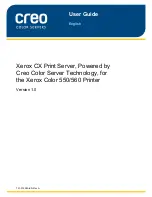
Option
Description
iDRAC
Select
DHCP
or
Static IP
to configure the network mode. If
Static IP
is selected, the available fields are
IP
,
Subnet (Sub)
, and
Gateway (Gtw)
. Select
Setup DNS
to enable DNS and to view domain addresses. Two
separate DNS entries are available.
Set error
Select
SEL
to view LCD error messages in a format that matches the IPMI description in the SEL. This enables
you to match an LCD message with an SEL entry.
Select
Simple
to view LCD error messages in a simplified user-friendly description.
For more information about error messages, see the
Event and Error Message Reference Guide for 14th
Generation Dell EMC PowerEdge Servers
.
Set home
Select the default information to be displayed on the
Home
screen. See View menu section for the options and
option items that can be set as the default on the
Home
screen.
View menu
NOTE:
When you select an option in the View menu, you must confirm the option before proceeding to the next action.
Option
Description
iDRAC IP
Displays the
IPv4
or
IPv6
addresses for iDRAC9. Addresses include
DNS
(
Primary
and
Secondary
),
Gateway
,
IP
, and
Subnet
(IPv6 does not have Subnet).
MAC
Displays the MAC addresses for
iDRAC
,
iSCSI
, or
Network
devices.
Name
Displays the name of the
Host
,
Model
, or
User String
for the system.
Number
Displays the
Asset tag
or the
Service tag
for the system.
Power
Displays the power output of the system in BTU/hr or Watts. The display format can be configured in the
Set
home
submenu of the
Setup
menu.
Temperature
Displays the temperature of the system in Celsius or Fahrenheit. The display format can be configured in the
Set
home
submenu of the
Setup
menu.
Locating the Service Tag of your system
You can identify your system using the unique Express Service Code and Service Tag. Pull out the information tag in front of the system
to view the Express Service Code and Service Tag. Alternatively, the information may be on a sticker on the chassis of the system. The
mini Enterprise Service Tag (EST) is found on the back of the system. This information is used by Dell to route support calls to the
appropriate personnel.
Figure 15. Locating Service Tag of your system
1. information tag (top view)
2. information tag (back view)
3. OpenManage Mobile (OMM) label
4. iDRAC MAC address and iDRAC secure password label
5. Service Tag
PowerEdge R740xd system overview
21
















































